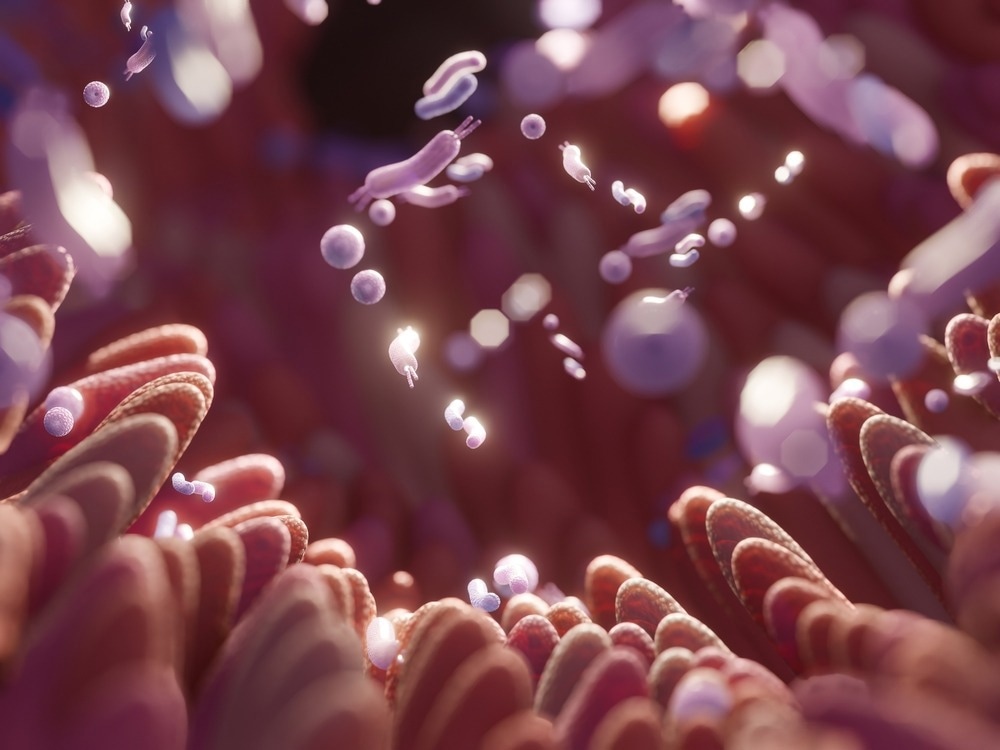In a recent Microorganisms journal study, scientists performed in vitro and in vivo experiments to investigate the antimicrobial effects of different bile acids on various microorganisms.

Study: Bile Acids: Major Regulator of the Gut Microbiome. Image Credit: Troyan / Shutterstock.com
Bile acids
Primary bile acids are synthesized from cholesterol in the liver, which is transformed to cholic acid (CA) through the classical pathway and chenodeoxycholic acid (CDCA) as an alternative pathway.
Primary bile acids are dehydroxylated by the intestinal microbiota to form secondary bile acids. Generally, deoxycholic acid (DCA) and lithocholic acid (LCA) are regarded as secondary bile acids. Most bile is re-absorbed in the small intestine, while 5% is excreted in the stool.
Bile acids in the GI tract
Every bile acid affects the intestinal microbiota differentially. For example, some bile acids exhibit bactericidal and bacteriostatic effects against microbes.
Bile acids disrupt bacterial membranes and damage their DNA. Furthermore, these acids regulate host immunity by controlling nuclear receptors, such as the farnesoid X receptor (FXR) and vitamin D receptor (VDR).
Microorganisms counter the antimicrobial effects of bile acids through several mechanisms, such as modulation of the efflux system, stress responses, DNA repair, and cell envelope remodeling. Additionally, intestinal microorganisms also play an important role in intestinal bile acid composition by deconjugation, dihydroxylation, and epimerization. The interactions between intestinal microbiota and bile acids help maintain intestinal homeostasis.
Supplementation of specific bile acids, such as ursodeoxycholic acid (UDCA), has certain therapeutic indications. Constant supplementation of specific bile acids affects the bile acid composition of the intestinal tracts, thus altering the intestinal microbiota diversity.
About the study
The large intestine is divided into the cecum, colon, rectum, and anal canal. The cecum harbors a high concentration of microorganisms and functions as a microbial reservoir that supplies microbes to the colon.
As compared to humans, the rodent cecum lumen is prominently separated from the colon lumen. Thus, animal models representing cecal microbiota may not be analogous to human colonic microbiota.
In the current study, antibiotic susceptibility through the disc diffusion method was examined. The antimicrobial effect of the bile acid pool was investigated through in vivo experiments using a rodent model. In vivo experiments on commonly found microbial strains in the biliary tract and intestinal tracts, such as Enterococcus faecalis, Proteus mirabilis, and Escherichia coli, were conducted.
Several previous studies have indicated that these microorganisms selectively inhabit the colon and cecum. The effect of bile acids on Lactobacillus casei was also determined, as this bacterium is commonly present in most commercially available probiotics.
Fecal samples from the cecum and colon of mice were also collected to determine differences in the intestinal microbial composition.
Study findings
As compared to pathogens or other infectious microorganisms, intestinal microbes were less susceptible to bile acids. Pathogenic microbes are rarely detected in the intestinal tract; however, they are often found in other organs. This suggests the presence of a potent factor that inhibits the growth of certain pathogenic microbes.
During infection, an increased level in bile-resistant microorganisms, such as Enterococcus faecalis and Klebsiella pneumoniae, was identified. This observation further corroborates the fact that bile acids can inhibit specific pathogens, while not affecting others.
The antimicrobial effect varied significantly across different microorganisms, even against similar bile acids. The hydrophobic properties of bile acids contribute to their antimicrobial properties; however, the current study reports that these effects of bile acids are not correlated with hydrophobicity.
For example, LCA is a highly hydrophobic bile acid that exhibits low antimicrobial activity. Thus, in addition to hydrophobic characteristics, other factors also contribute to the antimicrobial activity of bile.
Most bile acids exhibited strong antimicrobial activity against commercially available probiotics. This suggests that bile acids may restrict the benefits offered by externally supplemented probiotics.
The in vivo studies reported differential microbial composition in the cecum and colon. The microbial composition of the colon in CDCA and DCA treatment groups was different from that of the control group.
The reversal of the Firmicutes/Bacteroidetes ratio indicated that the cecum acted as a reservoir of colonic microbiotas. When the colon encounters microbial changes, microorganisms from the cecum migrate to the colon to balance the changes.
Conclusions
One of the limitations of this study is related to the assessment of the effect of bile on microbes only in the intestinal lumen and not in the mucus layer. Nevertheless, bile acids exhibited prominent antimicrobial effects against intestinal microbiota in accordance with microbial strain and type of bile acid.
Importantly, both in vivo and in vitro experiments exhibited similar antimicrobial effects, suggesting that, as compared to cecal microbes, colonic microorganisms were more susceptible to bile acids. Intestinal microbiota composition can be effectively regulated through fecal transplantation and administration of bile acids and probiotics.